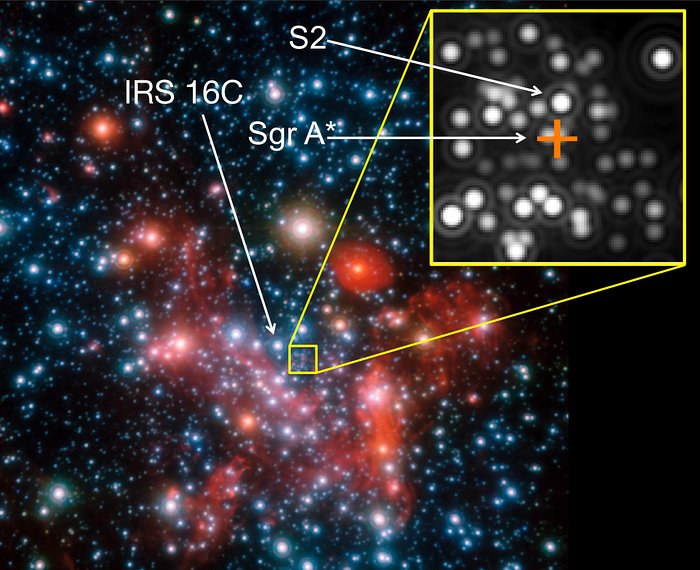Situated at about 25 000 light years from the Solar System, in the constellation of Sagittarius, , the center of the Milky Way harbors a massive black hole with a mass of about 4 million times that of the Sun.
On June 17th 2016, the Gravity instrument was pointed for the fisrst time towards the centre of our galaxy, in order to observe the star S2 which orbits a black hole with a period of 16 years.
Animation du chemin de la lumière à travers l’instrument GRAVITY par observatoiredeparis
The position and mass of the star S2 are well known since 2002, when its orbit was determined for the first time.
During the following 16 years, the path of the sar has followed a tiny 0.2 sec elllipse in the sky. The apparent size of this path is somewhat like that of a football field on the Moon as seen from the Earh.
Although the instruments of the previous generation were able to determine the mass of the black hole, testing the theory of general relativity requires one to be able to measure the position of the star with an accuracy equivalent to a centimetre in this same imaginary football field on the Moon.
Successful tests, obtained in time
GRAVITY has shown in an impresive way that it has the sensitivity necessary to detect the interference fringes of this star in a time of just a few seconds : this constitutes a record of many magnitudes for optical interferometry and opens the way to observing the effects of Einstein’s theory of general relativity around black holes.
Neither the target star, nor the reference star closesby appear to be binary, a good sign for the coming measurement which would otherwise have been much more difficult.

It was vital to do these tests with GRAVITY since the star S2 will come close to the black hole in 2018, at a moment when the effects of general relativitgy are expected to be very important.
At that time, the star will will be only 17 light hours away, and have a speed of almost 8 000 km/s, i.e. 2,5% that of light. This latter is one thousand times faster than that of the international space station in orbit around the Earth.
The orientation of the elliptical path of S2 will change in 2018 because of general relativity, and will turn by about 0,2°. This is an order of magnetude larger than the effect of general relativity on the orbit of Mercury, the planet closest to the Sun. The next time that such an event will be observable close to the black hole will be in 2033 The first promising tests show that the team will be able in the near future to obtain extremely accurate measurements of the orbiting star, and to see whether the stellar motion around the black hole does satisfy the laws of general relativity.
The result of a collaboration between the Max Planck Institute for Extraterrestrial Physics (MPE) and that of Astonomy (MPIA) in Germany, the Paris Obbservatory via its Laboratoire d’Études Spatiales et d’Instrumentation en Astrophysique, l’IPAG of the Université Grenoble Alpes/CNRS,Cologne University, the Lisbon and Porto Multidisciplinary Centre for Astrophysics et Porto (SIM) and the European Southern Observatory (ESO), this new GRAVITY instrument was specifically designed for this objective.
GRAVITY : an improvement by a factor of 15
This will be an interferometer, i.e. it will combine the light from the four VLY 8 meter telescopes on the Paranal mountain in the Atacama desert in Chile.

Each of the 8 metre telescopes is also being equiped with an infrared adaptive optics system for the Coudé focus (CIAO) in order to improve the sensitivity of GRAVITY for dusty regions such as the galactic centre.
The interferomertic combination of light leads to an angular resolution equivalent to that of a 130m diameter telescopeThe resolving power and accuracy are thereby improved by a factor of 15 with respect to that of an 8m telescope. This is vital in order to be able to test Einstein’s theory of General Relativity in the galactic centre.
Having built this super accurate machine over the last ten years, the team was confronted with two vital questions : does GRAVITY have the sensitivity to observe the dim stars in orbit around the galactic centre, and will this "laboratory" have the right "test particles" to measure precisely the effects predicted by Einstein’s theory of general relativity ?
The preliminary answers to these questions are overwhelmingly positive. They are a vital step for testing Einstein’s theory of general relativity, and show that the galactic centre does satisfy the requirements for being an ideal laboratory for this kind of research.
